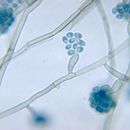en
names in breadcrumbs


Chaetothyriales és un ordre de fongs dins la classe Eurotiomycetes i dins del subfílum Pezizomycotina.
Chaetothyriales és un ordre de fongs dins la classe Eurotiomycetes i dins del subfílum Pezizomycotina.
Die Chaetothyriales sind eine Ordnung der Schlauchpilze und bestehen aus zwei recht unterschiedlichen Familien, den Chaetothyriaceae und Herpotrichiellaceae.
Die Arten der Ordnung bilden ein dunkles Myzel, das bei den Chaetothyriaceae als loses Netz von Hyphen ausgebildet ist, bei den Herpotrichiellaceae als unauffälliges Mycel. Die Fruchtkörper sind Perithecien. Das Hamathecium besteht aus kurzen Periphysoiden. Die Asci öffnen sich fissitunicat. Die Sporen sind hyalin bis hellgrau, transvers septiert bis muriform.
Anamorphe zeichnen sich durch melanisierte Hyphen aus. Manche Formen bilden auch Hefe-artige, meristematische und fädige Formen. Die Konidien werden annellidisch, phialidisch oder blastisch gebildet.
Die Chaetothyriales bilden keine Flechten. Die Chaetothyriaceae sind Epiphyten, wobei unklar ist, ob sie saprobiontisch oder biotroph leben. Die Herpotrichiellaceae sind Saprobionten, manche Anamorphe sind Pathogene bei Tieren, auch dem Menschen.
Während die Chaetothyriaceae vor allem in den Tropen auf Blättern und Rinden vorkommen, sind die Herpotrichiellaceae weltweit verbreitet. Die sexuellen Formen wachsen auf toten Pflanzen und auf Holz, die vegetativen Formen (Anamorphe) sind sehr weit verbreitet und finden sich auch in Badewasser, auf Pflanzen und im Boden.
Die Chaetothyriales gehören zur Unterklasse der Chaetothyriomycetidae und sind eine natürliche Verwandtschaftsgruppe, ein monophyletisches Taxon. Das Kladogramm der Unterklasse sieht folgendermaßen aus:[1]
Chaetothyriales
Eriksson führt für die Ordnung zwei Familien mit folgenden Gattungen auf:[2]
Manche Arten der Herpotrichiellaceae, die sogenannten Schwarzen Hefen, sind Krankheitserreger und befallen die Haut und das Nervensystem.
Die Chaetothyriales sind eine Ordnung der Schlauchpilze und bestehen aus zwei recht unterschiedlichen Familien, den Chaetothyriaceae und Herpotrichiellaceae.
The Chaetothyriales are an order of ascomycetous fungi in the class Eurotiomycetes and within the subclass Chaetothyriomycetidae.[1] The order was circumscribed in 1987 by mycologist Margaret Elizabeth Barr-Bigelow.[2]
As of October 2021, Species Fungorum includes 9 families, 97 genera, and 691 species in the Chaetothyriales.[3] The following list shows the families, genera, and number of species in the Chaetothyriales, adapted from a recent (2020) taxonomic and nomenclatural review of the order.[4]
Several genera have been included in the Chaetothyriales although their familial placement is unknown. These include:
The Chaetothyriales are an order of ascomycetous fungi in the class Eurotiomycetes and within the subclass Chaetothyriomycetidae. The order was circumscribed in 1987 by mycologist Margaret Elizabeth Barr-Bigelow.
Chaetothyriales es un orden de hongos ascomicetos en la clase Eurotiomycetes y en el subfilo Pezizomycotina.
Una entidad de enfermedad que se limita en gran medida a Chaetothyriales es la infección cerebral primaria en individuos inmunocomprometidos o inmunocompetentes, es decir, cerebritis en la que los primeros síntomas de la enfermedad son de naturaleza neurológica. Los elementos hifales que muestran melanización ya sea directamente o después de la tinción de Fontana-Masson se observan en abscesos en la parénquima cerebral. El portal de entrada puede ser el pulmón, pero con frecuencia los síntomas se limitan al cerebro. Cinco especies representan la mayoría de las infecciones cerebrales no traumáticas. Cladophialophora bantiana ha causado alrededor de un tercio de los casos en individuos sanos.[1]
Familia Chaetothyriaceae
Familia Herpotrichiellaceae
Chaetothyriales es un orden de hongos ascomicetos en la clase Eurotiomycetes y en el subfilo Pezizomycotina.
Una entidad de enfermedad que se limita en gran medida a Chaetothyriales es la infección cerebral primaria en individuos inmunocomprometidos o inmunocompetentes, es decir, cerebritis en la que los primeros síntomas de la enfermedad son de naturaleza neurológica. Los elementos hifales que muestran melanización ya sea directamente o después de la tinción de Fontana-Masson se observan en abscesos en la parénquima cerebral. El portal de entrada puede ser el pulmón, pero con frecuencia los síntomas se limitan al cerebro. Cinco especies representan la mayoría de las infecciones cerebrales no traumáticas. Cladophialophora bantiana ha causado alrededor de un tercio de los casos en individuos sanos.
Chaetothyriales é uma ordem de fungos pertencentes à divisão Ascomycota da classe dos Eurotiomycetes.[1]
Chaetothyriales é uma ordem de fungos pertencentes à divisão Ascomycota da classe dos Eurotiomycetes.